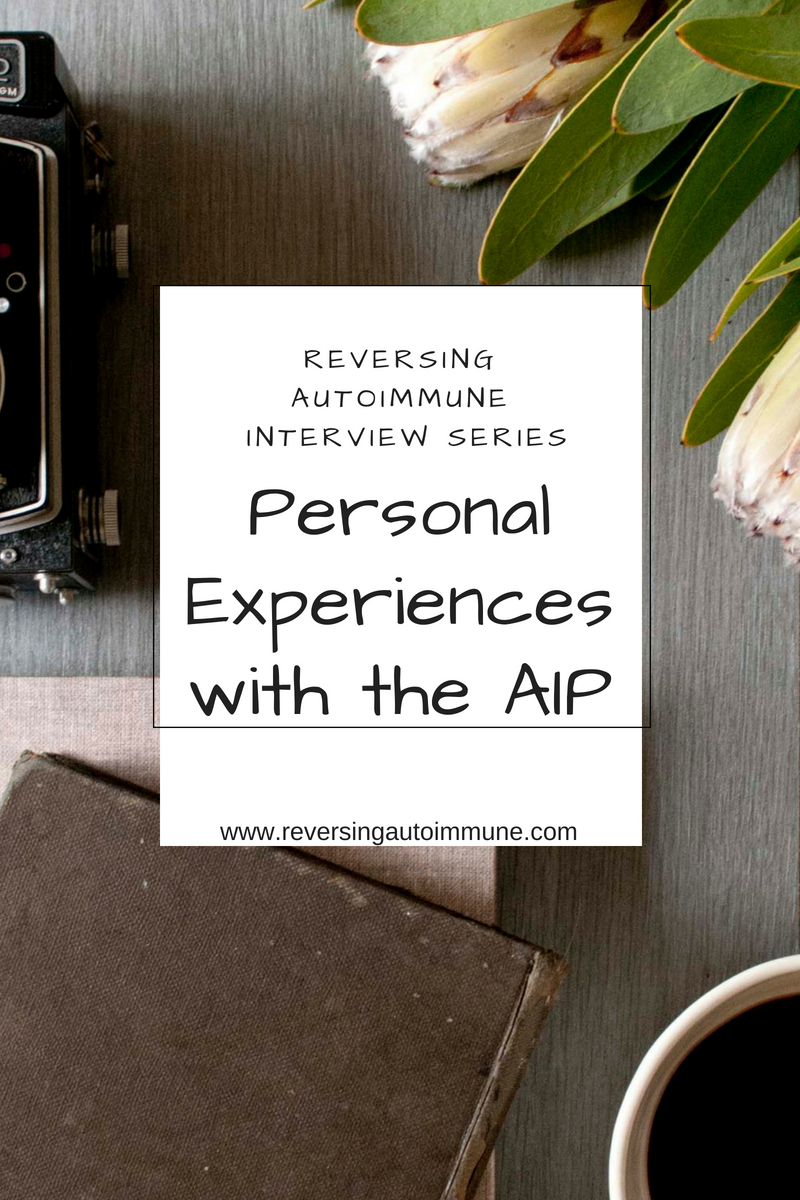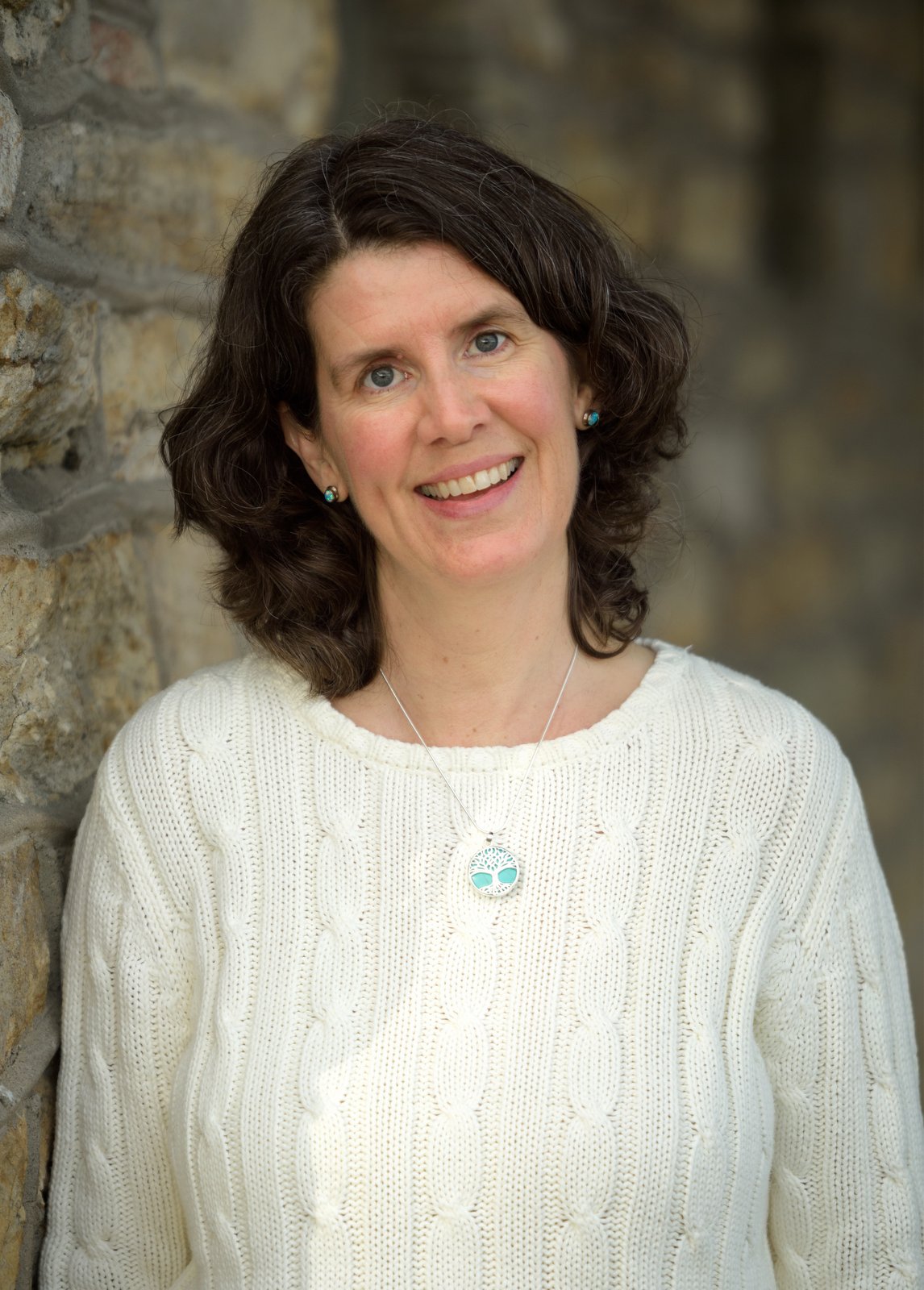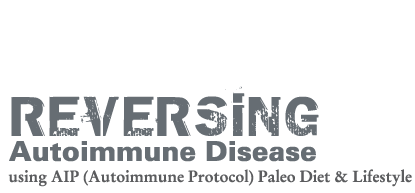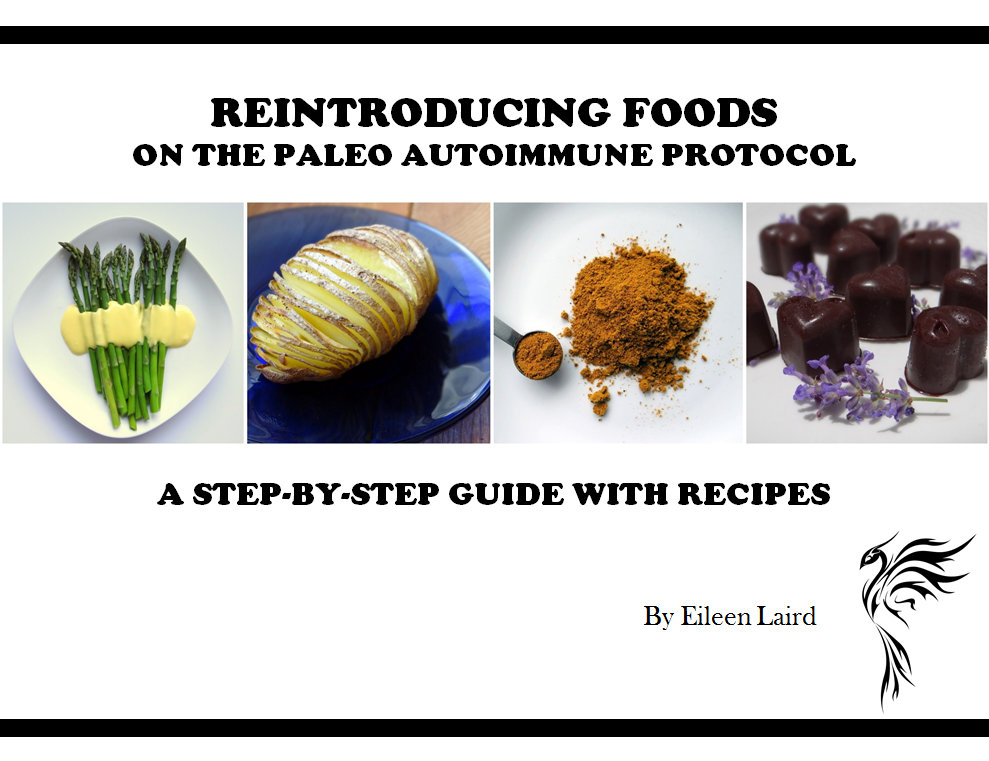Reversing Autoimmune Interview Series – Eileen

The Autoimmune Protocol (AIP) has helped so many people to reverse their autoimmune symptoms and for many people reverse the disease completely. It is however, not a one size fits all approach, and as we learn more and more about autoimmune diseases, we have started to discover that a more individual approach may be better. Unfortunately, at this stage, an elimination phase of removing all the main inflammatory foods and then slowly reintroducing them one at a time, is still the gold standard to work what individual triggers affect each person. (read more about the science behind the AIP and more about reintroducing foods)
Each person has their own unique experiences of AIP, regarding what foods they can and cannot tolerate and what lifestyle factors they have included. In this interview series, I ask different people about their own personal experience with AIP.
The things that are unique to all of us is how long the elimination lasted, what foods we react to and what foods we do not. The other vital factor is finding ways to reduce stress, incorporate exercise, work on relationships and deal with emotional issues are also vital aspects that mustn’t be overlooked. If you are someone considering trying AIP and are unsure, I hope that these interviews may help to show that no matter the name of your disease, or what foods you react to, everyone needs to find their own way of making AIP work for them and that it is possible to do that in whatever way works for you.
Eileen’s Personal Experience with the AIP
Eileen Laird is a writer, podcast host, and autoimmune warrior, who is living a vital life with Rheumatoid Arthritis through a combination of diet, lifestyle, mindset, and medication. She’s the voice behind the Phoenix Helix blog and podcast, and the author/editor of four books including: A Simple Guide to the Paleo Autoimmune Protocol and Reintroducing Foods on the AIP,

(My notes are in brackets)
1.What Autoimmune Disease/s do you have?
2.When did you start doing the AIP and what motivated you to do it?
I went paleo in the summer of 2012 after being diagnosed with RA. My symptoms improved somewhat, but I was still experiencing joint pain and flares, so I started the AIP in January of 2013.
3.What symptoms did you experience before going on AIP?
I experienced severe and rapid onset of rheumatoid arthritis. I went from zero symptoms to being disabled within 6 months. At my worst, pain kept me awake at night, and I woke up feeling like I was 90 years old with body-wide joint pain. I limped with every step and lacked the strength in my hands to wash dishes or my hair. And that was just my baseline. Every night a different joint would flare so extremely that it would have to be immobilized or I would be gasping with pain. I called it Flare Russian Roulette. If it was my shoulder, it went into a sling. If it was my wrist, it went into a brace. If it was my ankle, I had to get off my feet for the night. If it was my jaw, I couldn’t open my mouth to speak or eat. Prior to RA, I had worked full-time as a deep-tissue massage therapist and hiked on the weekends for fun. It was a terrifying and dramatic change. ( For more about the grief of being diagnosed with an Autoimmune Disease)
4.What symptoms went away after going on AIP?
The AIP reduced my pain by 95%, and over time my flares diminished until I went years between flares. I was able to return to work full-time (although I shifted to lighter touch massage therapies). I was also able to do all domestic chores again and return to the mountain hikes that I love.
5.What (if any) symptoms still remain?
After the AIP, I still needed 1 Aleve tablet twice a day to manage the remaining inflammation. That allowed me to live a pain-free life. Prior to the AIP, no amount of medication seemed to touch the pain. However, I never reached complete remission. 4 years later, I started to experience joint damage and made the choice to start immunosuppressant medication. Now, I’m in remission through a combination of diet, lifestyle, mindset and medication.
6. How long did you do the Elimination Phase of the AIP?
6 weeks, but I was paleo for 5 months before that.
7.Which foods did you find you react to or made your disease worse?
I reacted most strongly to nightshades and dairy, even in small amounts. With nuts, I could have some occasionally, but they become inflammatory if I ate them every day.
8.Are there any foods that are AIP compliant that you cannot tolerate or foods that aren’t that you can?
I need to limit my starch. Like nuts, it has a cumulative inflammatory response for me. I can have low-starch vegetables regularly -like butternut squash-, but I limit the dense starches -like sweet potatoes and plantains. I avoid cassava altogether -which has the highest starch content. As far as non-paleo foods, I do well with white rice, and I’ll enjoy corn-on-the-cob in the summertime. I still avoid most other grains and legumes. However, since I’ve been in remission, my food tolerance has expanded. This gives me more freedom with restaurant meals. I can now eat occasional nightshades and dairy, and I’ve even had gluten-free pizza twice, but I still stay mostly AIP at home. I’ve never tried reintroducing gluten. And I avoid all fake food -packages with ingredients you can’t pronounce. I prefer real food instead.
9.What lifestyle modifications did you introduce? Did that make any difference to how you feel?
I’m a big believer that autoimmune health is about more than just food. When I was at rock bottom with RA, I kept a gratitude journal to shine a light into the darkness I was feeling. I needed to see that there was a world outside of the pain. Once my symptoms improved enough to allow me to start sleeping better, I did a 30-day sleep challenge to get on a regular sleep schedule and felt my inflammation reduce even more. I now sleep 8-9 hours almost every night. I also practice meditation daily and pay attention to my mindset throughout the day. I’m not perfect, but I’m much more tuned in than I was pre-RA. I can feel it when my stress response goes up, and meditation dials it back down again. Lastly, regularly making room for joy in my life has become especially important. It’s easy to get obsessed with autoimmune disease when you’re trying to heal. I certainly did! Now, my goal is for it to be a thread in my life, but not the central focus on my life. ( For more on Lifestyle Tips on AIP)
10. Did you take any medication before you began AIP and do you take any now?
My goal with the AIP was to avoid medication, and I did avoid immunosuppressants for the first few years. But while the AIP reduced my pain and slowed the progress of my disease, it isn’t a cure. Once it was clear that joint damage was happening in spite of my best efforts, I started immunosuppressant medication. Now, the combination of diet + medication has put me in remission. (For more on my medication decisions)
11. Do you do any exercise, is it any different to what you did before?
Prior to RA, I enjoyed hiking in the mountains and yoga at home. After RA, I limped crossing my living room and even the gentlest stretch could cause a flare. At that point, deep breathing was the only form of exercise I could do. As I got better, I was able to take short walks, and then long walks, and eventually returned to the hiking that I loved. But it wasn’t until I was in remission and all joint inflammation was gone that yoga became enjoyable again. It’s funny, because people often recommend yoga and walking as exercise that “anyone can do.” For me, that definitely wasn’t true. I’m incredibly grateful to enjoy both again.
12.What was the easiest part of doing the AIP?
The way it’s improved my life. The pain relief, the energy rejuvenation, the empowerment I feel that my choices make a difference in my health. Rheumatoid arthritis is the toughest thing I’ve ever experienced. I named my blog Phoenix Helix after the mythical bird that rises from the ashes. The pain of RA was so intense that I felt like I was on fire. I desperately hoped to rise above those flames, and the AIP helped me do that.
13.What was the hardest part of doing the AIP?
The elimination phase. Feeling restricted tapped into my rebel nature. I struggled with feelings of anger and resentment. This was also before any cookbooks existed and very few blogs. I felt like the flavor had been sucked out of my kitchen, and the learning curve was very steep. But once I did reintroductions, those feelings went away. Partly because I got some foods back, but even the “failed” reintroductions helped, because I got a clear reason for avoiding that food. It wasn’t a random rule. It was pain, and no food’s worth that to me.
14. Were your family/spouse/friends supportive of your decisions; if not, did they change their minds afterwards?
My husband was very supportive. I’m so grateful for that, because I know what a difference that makes. We removed all the foods I couldn’t eat from our home. He continued to eat non-paleo foods at work and when he was away from home, but he never ate them in front of me. I think it would have been much harder if he was bringing home pizza and cookies. Instead, he at (and still eats) AIP meals right alongside me. My parents and siblings thought I was crazy, but when they saw my symptoms improve, most of them got on board. Now when I visit my mother, we cook AIP meals together. And some of my closest friends have invited me over for dinner and prepared AIP meals. That was such a gift! (social interaction is a vital aspect to the AIP. Here is a list of support groups around the world)
15.If you had to start the AIP all over again, would you do anything differently?
Hmmmm. That’s a tough one. We can’t go back in time, and I don’t regret any step in my journey. But sometimes I wish I hadn’t seen diet and medication as an either/or choice when I got diagnosed. They can be a powerful combination, and for many people -myself included, they work better together than either does alone.
16. Would you recommend it to someone else with autoimmune disease?
I would recommend it to everyone with autoimmune disease. The food we eat, and the lifestyle we live, has a dramatic impact on health at every level, but especially the hypersensitive autoimmune body. There is so much beyond our control, which is frightening with autoimmune disease. It’s empowering to take control where we can, and incredibly rewarding to experience the benefits.
*
(I was also lucky enough to be interviewed by Eileen on her blog all about the important aspect of Reintroducing Foods on the AIP. You can read it here )
This is part in a series of Interviews. Click here to see:
Interview with Kerry Interview with Tina. Interview with Alissa.





